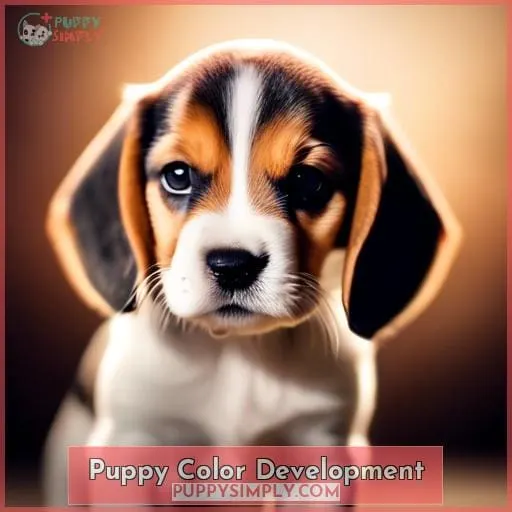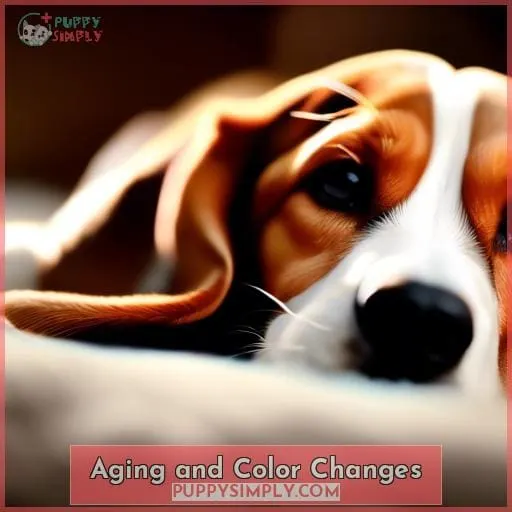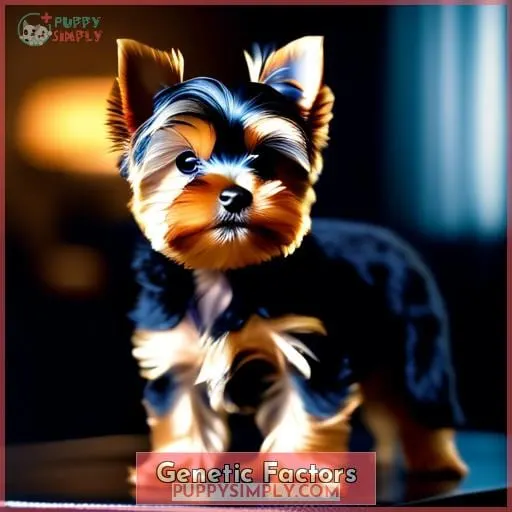This site is supported by our readers. We may earn a commission, at no cost to you, if you purchase through links.
 Just like a painter’s palette evolves with each stroke, your Beagle’s coat may transform as they age.
Just like a painter’s palette evolves with each stroke, your Beagle’s coat may transform as they age.
You’ve likely noticed subtle shifts in their fur, a common curiosity among Beagle owners.
Indeed, Beagles change color, a fascinating process influenced by genetics and age.
From the dynamic hues of puppyhood to the dignified greys of maturity, your furry companion’s coat tells a story of growth and change, reflecting their journey alongside you.
Embrace the variations, as they’re a testament to your Beagle’s unique identity and the life you share.
Table Of Contents
- Key Takeaways
- Beagle Color Basics
- Puppy Color Development
- Aging and Color Changes
- Genetic Factors
- Tracking Color Progression
- Unique Color Markings
- Frequently Asked Questions (FAQs)
- How does nutrition impact a beagle’s coat color?
- Can medical conditions besides hypothyroidism cause color changes in beagles?
- What are some myths or misconceptions about color changes in beagles?
- How can I tell if my beagle’s color changes are normal or a sign of an underlying issue?
- Why do some beagle littermates have different color changes even though they have the same parents?
- Conclusion
Key Takeaways
- Beagles display color diversity and variation including classic tri, black back tri, dark tri, faded tri, and rare colors like redtick, lemon, and fawn.
- Puppy beagles are born black and white then mature around 15 months with color changes from black to brown due to shifting hormone levels.
- Aging beagles commonly start greying around 6 years old, with color pigmentation declining over time, though the rate of greying varies.
- Genetic factors significantly influence beagle color variations including inherited traits from parents, while environmental triggers like sunlight also impact pigment production and color changes.
Beagle Color Basics
Beagles come in many recognized color combinations, usually featuring the common tricolor patterns of black, white, and brown.
Typical tricolor variations seen in beagles include the Classic Tri, Black Back, Dark Tri, and Faded Tri patterns.
While the specific tricolor patterns may differ between individual beagles, these coats featuring black, white, and brown are most commonly observed in the breed.
Recognized Color Combinations
You’ll see beagles sporting different mixes of black, white, brown, tan, lemon, red, and bluetick markings approved by the American Kennel Club.
Though tricolor coats with white, black, and brown are most common, beagles exhibit remarkable coat diversity stemming from complex color genetics influencing rare variations like redtick, lemon, and fawn.
Tracking a beagle’s color changes reveals nature’s artistry.
Common Tricolor Patterns
The most common tricolor patterns you’ll see are the classic tri, black back tri, dark tri, and faded tri.
Classic Tri: White, brown, and black colors evenly distributed.
Black Back: Mostly black back with brown and white markings.
Dark Tri: Richer concentrations of black and brown over white areas.
Faded Tri: Softer brown hues blended throughout the white and black coat.
These beautiful tricolor combinations showcase the diversity across beagles’ fur coats and color transitions.
Puppy Color Development
As beagle puppies grow, their birth colors start to change.
Most beagles are born black and white, but the black fades to brown over time.
The extent of color change varies between individual puppies, but maturation typically completes around 15 months of age.
Birth Colors
Your newborn beagle pup starts out black and white.
Their birth coat color is determined by genetics, with color inheritance and prenatal color development predisposing their initial pigmentation.
As they mature, environmental factors like sunlight exposure can trigger shifts, leading some beagles to develop vitiligo – a lack of skin pigment in patches.
Even genetically predisposed colors can change during puppyhood.
Color Maturation Timeline
As your beagle puppy matures, you’ll notice their coat changing drastically over the first year.
The puppy blacks fade to brown by the age of 12-15 months when their mature coat color stabilizes.
This pigment transformation occurs as hormone levels shift, causing the beagle’s black hairs to transition in hue to brown.
Their unique color patterns continue emerging, though shade development slows after that first year.
Still, some tonal shifts may occur due to health issues like hypothyroidism.
Aging and Color Changes
As your beagle grows older, you may notice their coat beginning to gray and fade.
This lightening of color typically starts around 6 years old, usually appearing first on the face before spreading to the back and rest of the body.
Some beagles may go completely gray by age 5, while others will retain most of their color into old age.
Greying With Age
Out of the blue, your beagle’s coat starts showing touches of white and gray around 6 years or so.
This greying occurs as melanin production declines with age, causing a loss of color pigmentation.
Beagles commonly develop white or gray hair on their face, around their eyes and mouth initially.
This pigment loss leads to an overall lightening and gradual color transition in their coat.
Though less predictable than puppy color changes, greying follows natural patterns related to reduced melanin levels over time.
Color Fading Over Time
You’ll notice their black fur fading to brown over the years.
Sunlight exposure and hormonal influences can trigger pigment loss, gradually lightening your beagle’s coat.
This continuous color transition may involve complete depigmentation (vitiligo).
Tracking photos helps you appreciate the intriguing shifts.
Genetic Factors
You’ll notice distinct color variations among beagle littermates.
This points to genetic factors playing a key role.
Certain genes influence the amounts of pigment produced, leading to differing color patterns, even between pups from the same parents.
Birth Color Variations
One factor determining a beagle’s color progression involves the particular genetic variations they’re born with.
Certain color traits are intrinsically predetermined, though environmental effects can still trigger shifts over time.
The colors and patterns a beagle puppy displays at birth depend largely on the genetic makeup inherited from its parents.
Certain coat colors and variations are passed down through lineages, leading to common neonatal hues like black, white, and brown, along with more unique inheritance of markings like ticking or rare color dilution.
Still, appearance can change in response to external influences.
Color Change Triggers
Certain factors can trigger color changes in a beagle’s coat as they age.
You’d notice that some color shifts relate to their genetics, while others result from environmental influences.
- Hormonal influences like hypothyroidism
- Environmental factors such as sunlight exposure
- Sunlight causing loss of pigmentation
- Vitiligo resulting in drastic color change
- Changes to coat texture
Breed-Specific Traits
Your beagle’s gradual color changes over time are influenced by the breed’s genetic predisposition for pigment shifts.
As scent hounds, beagles are prone to coat evolution, with puppy blacks fading to browns and additional colors emerging.
Their friendly canine characteristics and aging patterns lead to fascinating natural coat changes.
Understanding the genetic factors behind color variations allows better tracking of your beagle’s unique color progression.
Tracking Color Progression
You can track your beagle’s color changes over time by regularly photographing him every few months.
Capturing images under consistent lighting conditions allows you to clearly see subtle shifts in shades and patterns.
Over a year or two, a photo timeline will visually depict the evolution of your pup’s coat.
Comparing photos side-by-side illustrates the fascinating progression of color changes.
For example, you may notice the black saddle fade to brown or white markings expand.
Monitoring changes through photos is an engaging way to appreciate the unique aspects of your beagle’s genetic makeup and document his visual progression from puppy to adult.
Consistent photo documentation enables precise observation of pigment and marking transformations over the years.
Unique Color Markings
You may notice some unique color markings develop on your beagle as they age.
Ticking, which is the appearance of small dots or speckles of color throughout the coat, may become more pronounced over time.
Rare color patterns like brindle, merle, or dapple may also emerge, adding greater diversity to your beagle’s one-of-a-kind coat.
Ticking and Freckles
A beagle’s distinctive ticking and freckles can make their coat markings all the more unique as they age.
As beagles mature, ticking often intensifies in patterns across the body, while freckles may appear sporadically on the legs and chest.
These age-related spots and markings highlight the individual personality and genetic profile of each dog.
Ticking displays in diverse arrangements, and freckling varies in distribution, adding to the singular charm of every beagle.
Rare and Unique Patterns
How uniquely might your beagle’s coat markings manifest over time?
Some beagles develop uncommon markings like brindle stripes, white tips on the tail or paws, or patchy color distributions.
While most have common tricolor coats, a small percentage of beagles exhibit distinctive coloration due to exceptional genetic factors and environmental influences.
These rare coat variations reveal the breed’s intriguing capacity for unique color schemes.
Frequently Asked Questions (FAQs)
How does nutrition impact a beagle’s coat color?
Unfortunately, I don’t have enough information to definitively state how nutrition impacts a beagle’s coat color.
A beagle’s coat color is primarily determined by genetics.
Environmental factors may play a secondary role.
Without scientific evidence on this specific topic, any claims about nutrition’s effect would be speculative.
Can medical conditions besides hypothyroidism cause color changes in beagles?
Yes, conditions like vitiligo can cause color changes in beagles.
This autoimmune disorder destroys melanocytes, causing depigmentation and often drastic coat color changes, usually beginning on the face.
Sun exposure and other factors may also contribute to pigment loss and color shifts over time.
Regular vet checkups can help monitor skin health.
What are some myths or misconceptions about color changes in beagles?
Unfortunately, some myths persist about Beagle color changes.
Rest assured, variations in their coats stem from natural developmental and genetic factors, not supernatural causes.
While fascinating to observe, these changes seldom indicate health issues.
Rather, they highlight the breed’s delightful diversity.
Focus instead on celebrating their endearing personalities.
How can I tell if my beagle’s color changes are normal or a sign of an underlying issue?
Changes in your beagle’s coat color are often normal.
However, significant or sudden shifts could indicate an underlying health issue.
Regular veterinary checkups can determine if changes are due to normal aging or a condition requiring attention.
Tracking photos over time helps identify abnormal alterations.
Why do some beagle littermates have different color changes even though they have the same parents?
Even littermates can have different color changes due to natural variation in genetics and environment.
Focus on appreciating your beagle’s unique coat transitions rather than comparing to siblings.
Each pooch’s coloring tells their own story.
Conclusion
Tracking your Beagle’s coat changes provides insight into their growth and genetics.
Subtle variations emerge with time—graying fur, fading colors—telling of their aging.
While shifts can raise questions, remember their unique markings make up your one-of-a-kind companion.
Value them in all their phases.
Through attentiveness to your Beagle’s looks, you deepen your bond and better understand the science behind their colorful charm.











